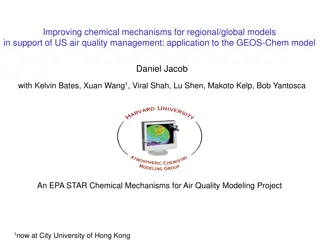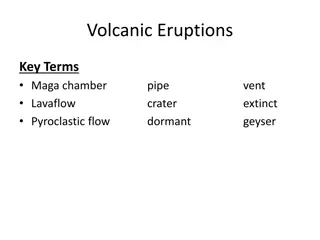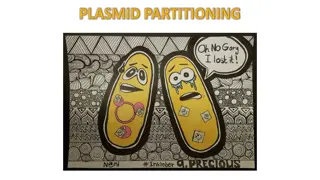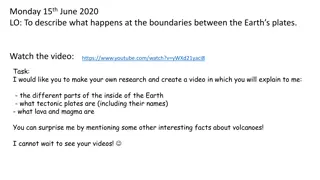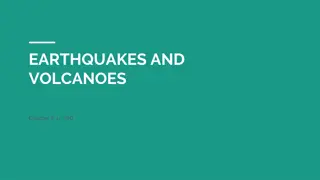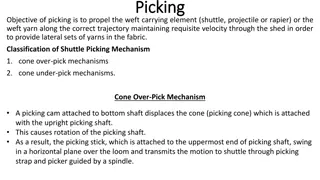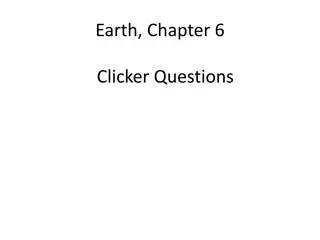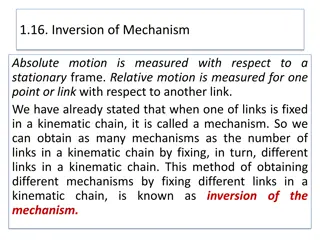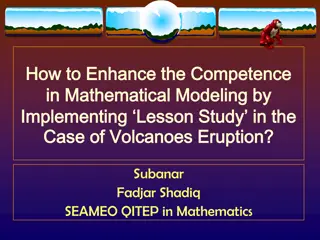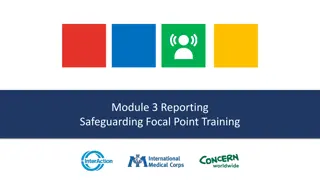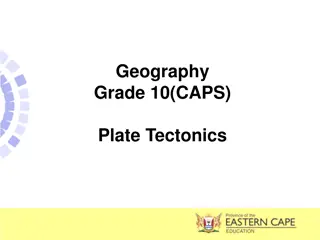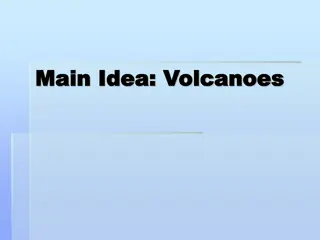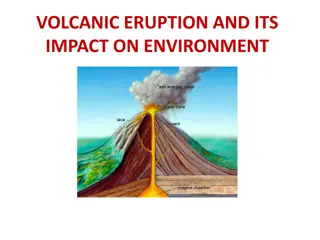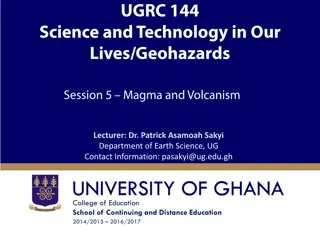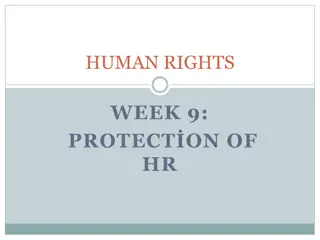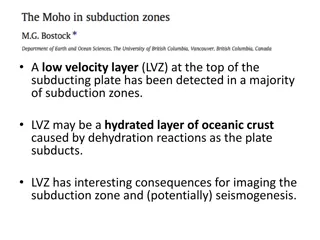Volcanoes: Mechanisms and Vulcanicity
Volcanoes, mechanisms of eruption, and vulcanicity are explored in geology and geography. Learn about volcanic vent characteristics, types of volcanoes, and classifications based on eruption modes. Vulcanicity encompasses processes involving magma ascent and surface appearance.
Download Presentation

Please find below an Image/Link to download the presentation.
The content on the website is provided AS IS for your information and personal use only. It may not be sold, licensed, or shared on other websites without obtaining consent from the author.If you encounter any issues during the download, it is possible that the publisher has removed the file from their server.
You are allowed to download the files provided on this website for personal or commercial use, subject to the condition that they are used lawfully. All files are the property of their respective owners.
The content on the website is provided AS IS for your information and personal use only. It may not be sold, licensed, or shared on other websites without obtaining consent from the author.
E N D
Presentation Transcript
Concept of Vucanicity The terms volcanoes, mechanism of volcanoes and vulcanicity are more or less synonymous to common man, but these have different connotation in geology and geography. A volcano is a vent, or opening, usually circular or nearly circular in form, through which heated materials consisting of gases, water, liquid lava and fragments of rocks are ejected from the highly heated interior to the surface of the earth . (P.G. Worcester, 1948). On the other hand, the term vulcanicity covers all those processes in which molten rock material or magma rise into the crust or is poured out on its surface, there to solidify as a crystalline or semi crystalline rock (S.W. Woolridge and R.S. Morgan, 1959). Some scientists have also used the term of vulcanism as synonym to the term of volcanicity.
In other word words, vulcanicity or volcanism, which is related to both the environments, endogen tic and exogenetic. In other words vulcanicity includes all those processes and mechanisms which are related to the origin of magmas, gases and vapour, their ascent and appearance on the earth s surface in various forms.
Components of volcanoes Volcanoes of explosive type or central eruption type are associated with the accumulated volcanic materials in the form of cones which are called volcanic cones or simply volcanic mountains. There is a vent or opening, of circular or nearly circular shape, almost in the centre of the summital part of the cone. This vent is called as volcanic vent or volcanic mouth which is connected with the interior part of the earth by a narrow pipe, which is called as volcanic pipe. The enlarged from of the volcanic vent is known as volcanic crater and caldera. Volcanic materials include lavas, volcanic dust and ashes, fragmental etc.
TYPES OF VOLCANOES There is a wide range of variations in the mode of volcanic eruption and their periodicity. Thus, volcanoes are classified on the basis of:- 1). The mode of eruption 2). The period of eruption and the nature of their activities
Classification on the basis of the nature of volcanics eruption Volcanic eruption occur mostly in two ways. 1) Violent and explosive type of eruption of lava, volcanic dusts, volcanic ashes and fragmental materials through a narrow pipe and small opening under the impact of violent gases. 2) Quiet type or fissure eruption along a long fracture or fissure or fault due to weak gases and huge volume of lavas. (A long, narrow opening or line of breakage made by cracking or splitting, especially in rock or earth)
Volcanoes of central eruption type This types of eruption is so rapid and violent that huge quantity of volcanic materials consisting of lavas, volcanic dusts and ashes, fragmental materials etc. are ejected upto thousands of metres in the sky. These materials after falling down accumulate around the volcanic vent and form volcanic cones of various sorts. Such volcanoes are very destructive and are disastrous natural hazards Explosive volcanoes are further divided into 5 sub- types on the basis of difference in the intensity of eruption, Ejected material and the period of the action of volcanic events.
1.Hawaiin type of volcanoes Such volcanoes erupt quietly due to less viscous lavas and non-violent nature of gases. The Hawaiin people consider these long glassy threads of red molten lava as Pele s hair (Pele is the Hawaiin goddess of fire). Such volcanoes have been named as Hawaiin type because of the fact that such eruptions are very common occurrence on Hawaiin island. Example:- The eruption of Kilauea volcano of the southern Hawaiin island in 1959-60.
2.Strombolian type of volcanoes Such volcanoes, named after Stromboli volcano of Lipari island in the Mediterranean sea, erupt with moderate intensity. Beside lava, other volcanic materials like pumice, scoria, etc. are also ejected upto greater height in the sky. The eruption are almost rhythemic or nearly continuous in nature but some times they are interrupted by long intervals.
3.Vulcanian type of volcanoes These are named after vulcano of Lipari island in the Mediterranean sea. Such volcanoes erupt with great force and intensity. Consequently, the violent gases break and shatter the lava crusts into angular fragments and appear in the sky as ash-laden volcanic clouds of dark and often black colour assuming a convoluted or cauliflower shape.
4.Peleean type of volcanoes These are named after the Pelee volcano of Martinique island in the Caribbean sea. These are the most violent and most explosive type of volcanoes. The ejected lavas are most viscous. The most disastrous volcanic eruption of Mount Pelee on May 8, 1902 destroyed the whole of the town of St. Pierre. The more explosive eruption of Krakatoa volcano in 1883 in Krakatoa island located in Sunda Strait between Java and Sumatra.
5.Visuvious type of volcanoes These are more or less similar to vulcanian and Strombolian type of volcanoes, the difference lies only in the intensity of expulsion of lava and gases. There is extremely violent expulsion of magma due to enormous volume of explosive gases. The most destructive type of eruption is called as Plinian type because of the fact that such type of eruption was first observed by Plini in 79 A.D.
Fissure eruption type of volcanoes Such volcanoes occur along a long fracture, fault and fissure and there is slow upwelling of magma from below and resultant lavas spread over the ground surface. The speed of lava movement depends on the nature of magma, volume of magma, slope of ground surface and temperature conditions. Example:- The Laki fissure eruption of 1783 in Iceland.
Classification on the basis of periodicity of eruptions Volcanoes are divided into 3 types on the basis of period of eruptions and interval period between two eruptions of a volcanoes (i) active volcanoes (ii) dormant volcanoes (iii) extinct volcanoes
Active Volcanoes Active volcanoes are those which constantly eject volcanic lavas, gases, ashes and fragmental material. It is estimated that there are about more than 500 volcanoes in the world. Etna and Stromboli of the Mediterranean sea are the most significant example of this category. Stromboli volcano is known as Light House of the Mediterranean because of continuous emission of burning and luminous incandescent gases. Most of the active volcanoes are found in the mid- oceanic ridges.




